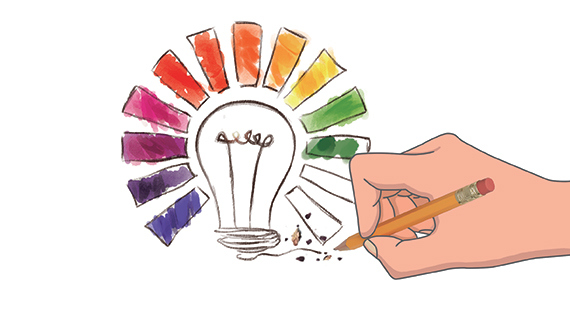
Whether you're a writer, an artist, an entrepreneur, or any one of the thousands of jobs in the world that require imaginative solutions, creativity, or 创造力 ( chuàngzàolī ), is what drives many of us forward. However, staying creative—in light of all the self-doubt, criticism, and hard work—is no easy task. It involves drawing the status quo into question and actively destroying preconceptions, often at great personal risk. This vantage point puts us in a better position to tackle one very special character: 创 . It's a character that means both "to start something new" and "wound or trauma", with a slight variation in tone. With its dual meanings, the character for creation signifies the arduous journey endemic in creating something entirely new.
To create, you have to suffer first. Judging by the evolution of the written form, we know that the character 创 , meaning "wound", appeared much earlier than the one for creativity. More than three millennia ago, it first appeared in the form of bronze script. Some have posited that the script's pattern indicates a person lying on the ground with incisions on the limbs; others claim it's actually a blade dripping with blood. Either way, its original definition was not debatable, meaning "to cut wounds". As the character developed, the original pattern was simplified and became a radical, and at the same time another radical, 倉 ( cāng ), was added on its left to denote pronunciation. The end result is 創 , the traditional form of the character 创 . When it refers to "wound" as a noun, the first tone ( chuāng ) is used.
Many words and phrases rely on the character, and all relate to its painful origins. 创口 ( chuāngkǒu , wound) is a word you will most likely hear from surgeons, and when discussing a surgery, you may want to choose a plan of action that uses the least invasive techniques, which is 微创 ( wēichuāng ). Surgeons refer to surface wounds as 创面 ( chuāngmiàn ) when they are discussing its cleaning or healing.
Of course, the character does not just refer to physical wounds, but also psychological or emotional trauma. For instance, the word 创伤 ( chuāngshāng ) can mean both physical and psychological injury. For instance, " 战争给人们的心灵留下了深深的创伤 ( Zhànzhēng gěi rénmen de xīnlíng liú xià le shēnshēn de chuāngshāng )" means "War leaves deep wounds in people's hearts." To refer to the pain and suffering caused by such injuries, use the word 创痛 ( chuāngtòng ). The meaning of "wound" also expands to include setbacks on other general matters. For example, when the economy takes a hit, we say 经济受创 ( jīngjì shòuchuāng ); when one's career is on the rocks, it's 事业受创 ( shìyè shòuchuāng ); and when someone's ego gets hurt, we can even say 自尊心受创 ( zìzūnxīn shòuchuāng ).rds and phrases rely on the character, and all relate to its painful origins. 创口 ( chuāngkǒu , wound) is a word you will most likely hear from surgeons, and when discussing a surgery, you may want to choose a plan of action that uses the least invasive techniques, which is 微创 ( wēichuāng ). Surgeons refer to surface wounds as 创面 ( chuāngmiàn ) when they are discussing its cleaning or healing.
















































